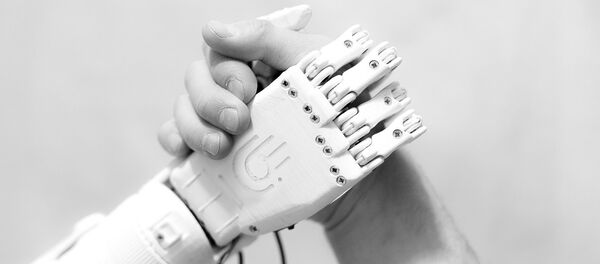The experimental application is the by the handiwork of researchers at Case Western Reserve University in Cleveland, Ohio, and the first in the world to restore brain-controlled reaching and grasping functions in individuals suffering from quadriplegia — the partial or complete paralysis of all four limbs, which effectively amounts to total paralysis.
Man with quadriplegia moves arm again with his thoughts, as part of clinical trial conducted by #CWRU researchers. https://t.co/KSndJIwOrG
— Case Western Reserve (@cwru) March 29, 2017
In a study published in The Lancet, the lead researchers on the project detail how their technology, which is based on a functional electrical stimulation system, has allowed a patient with quadriplegia to move their arms using only thought. The device doesn't remedy paralysis — it circumvents it by imbuing patients with the ability to bridge the gap between their brain and muscles created by their injury.
Sensors are surgically implanted in a patient's brain, in the area responsible for motor control, and by way of a brain-computer interface, patients effectively "tell" the computer how to move their affected limbs, and these commands are dispatched to the electrodes in his arm, stimulating muscles in their hand, wrist, elbow, and shoulder by making them contract.
To date, the procedure has been achieved successfully with one patient, a 53-year-old who paralyzed for eight years due to a cycling accident.
The scientists "translated" the patient's brain signals into electrical pulses, and over four months taught the brain-computer interface which movements corresponded to which brain signals, using a virtual reality limb.
The patient was equipped with the device for 12 months before he was able to carry out daily activities, such as eating and drinking. He had the technological implant for almost two years, during which time he has experienced very few, modest adverse reactions, which the team promptly addressed and resolved.
In tests, the participant managed to successfully drink on 11 out of 12 occasions, each task taking him between 20 and 40 seconds to complete. The patient was also able to control his arm, taking spoonfuls of food to his mouth several times. The participant needed to rely on his eyesight to control his arm, as full paralysis affects one's proprioception — the sense of the spatial position of one's limbs.
Over a follow-up period of 45 weeks, the patient's strength, endurance, and overall ability to move improved significantly.
"Our research is at an early stage, but we believe this could offer individuals with paralysis the possibility of regaining arm and hand functions to perform day-to-day activities, offering them greater independence. With further development, we believe the technology could give more accurate control, allowing a wider range of actions, which could begin to transform the lives of people living with paralysis," said Dr. Bolu Ajiboye, lead researcher on the project.
Commenting on the project Dr. Steve Perlmutter from the University of Washington hailed the study as "groundbreaking."
"The goal is futuristic: a paralyzed individual thinks about moving her arm as if her brain and muscles were not disconnected, and implanted technology seamlessly executes the desired movement. This is the first report of a person executing functional, multi-joint movements of a paralyzed limb with a motor neuroprosthesis," said Dr. Perlmutter, in a linked comment in the Lancet.
However, he said the treatment was evidently not ready for use outside laboratory conditions — the movements achieved were "rough and slow," required "continuous visual feedback" and had restricted range due to the use of a motorized device to assist shoulder movements
"The study is a proof-of-principle demonstration of what is possible, rather than a fundamental advance in neuroprosthetic concepts or technology. But it is an exciting demonstration nonetheless, and the future of motor neuroprosthetics to overcome paralysis is brighter," Dr. Steve Perlmutter added.
While the news is no doubt awe inspiring, transhumanism, the enhancement of human capabilities via science and technology, is a reality for many people already, to varying degrees.
For instance, amputees use prosthetics connected to their own nerves and controlled using electrical signals from the brain, and BrainGate helps tetraplegics regain motor independence — in 2014, a man with partial arm paralysis opened and closed his hand with the power of thought, using a brain implant and external electrodes equipped around his forearm.



